Impact of Motivational Theories in the Modern Workplace: A Report
VerifiedAdded on 2022/11/28
|7
|1875
|86
Report
AI Summary
This report provides a comprehensive overview of motivational theories and their practical application in the modern workplace. It begins with an introduction to the concept of motivation, defining its key elements and differentiating between intrinsic and extrinsic motivation. The main body of the report delves into various motivational theories, including Maslow's hierarchy of needs, Herzberg's two-factor theory, and Vroom's expectancy theory. The report emphasizes the relevance of Maslow's theory in contemporary business environments, using Zara as a case study to illustrate how psychological, safety, love and belonging, self-esteem, and self-actualization needs are addressed to foster employee satisfaction and motivation. It highlights how modern workplaces prioritize employee well-being and adapt to technological advancements to meet employee needs. The conclusion reinforces the importance of adopting motivational theories to enhance organizational performance and productivity, emphasizing the role of rewards, appraisals, and incentives in keeping employees engaged and motivated.
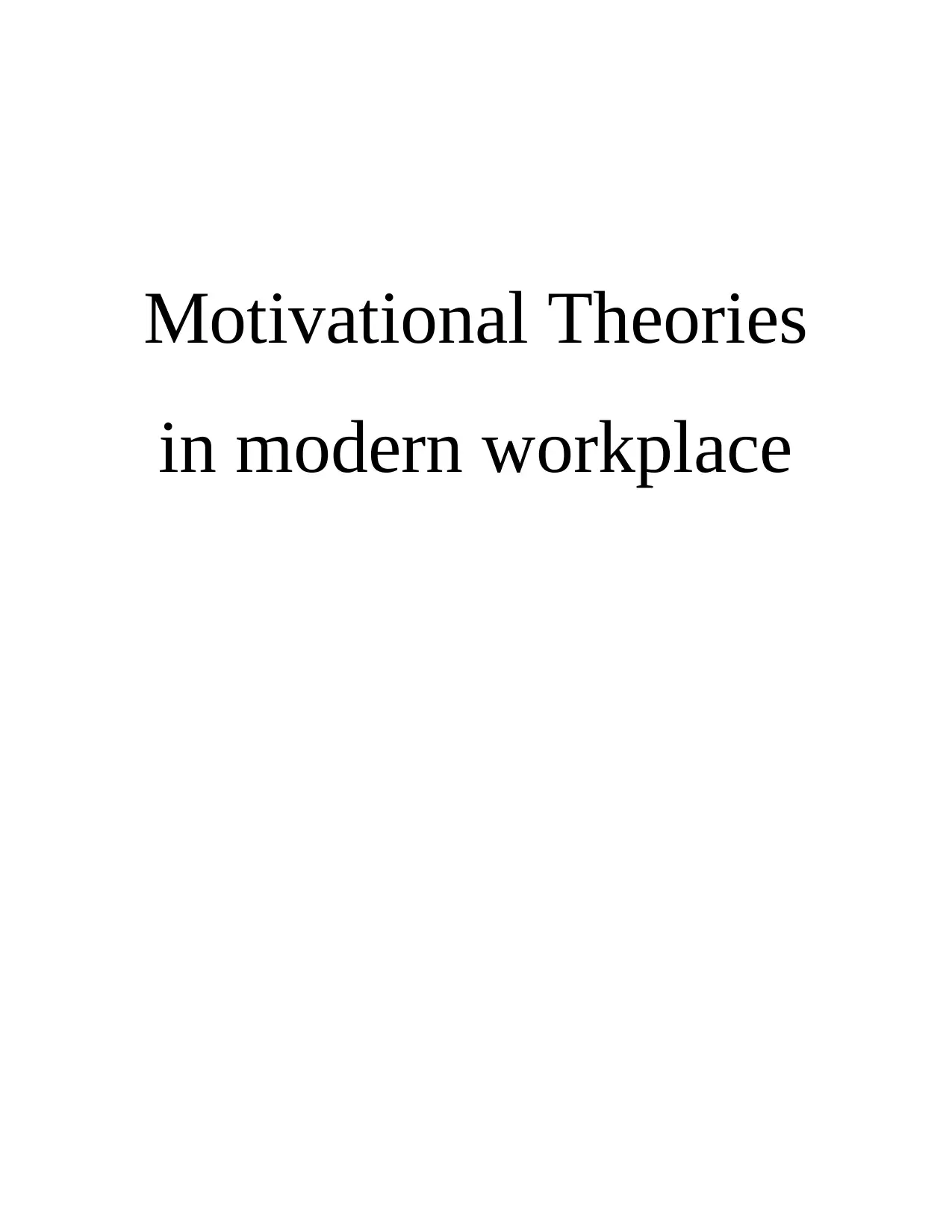
Motivational Theories
in modern workplace
in modern workplace
Paraphrase This Document
Need a fresh take? Get an instant paraphrase of this document with our AI Paraphraser
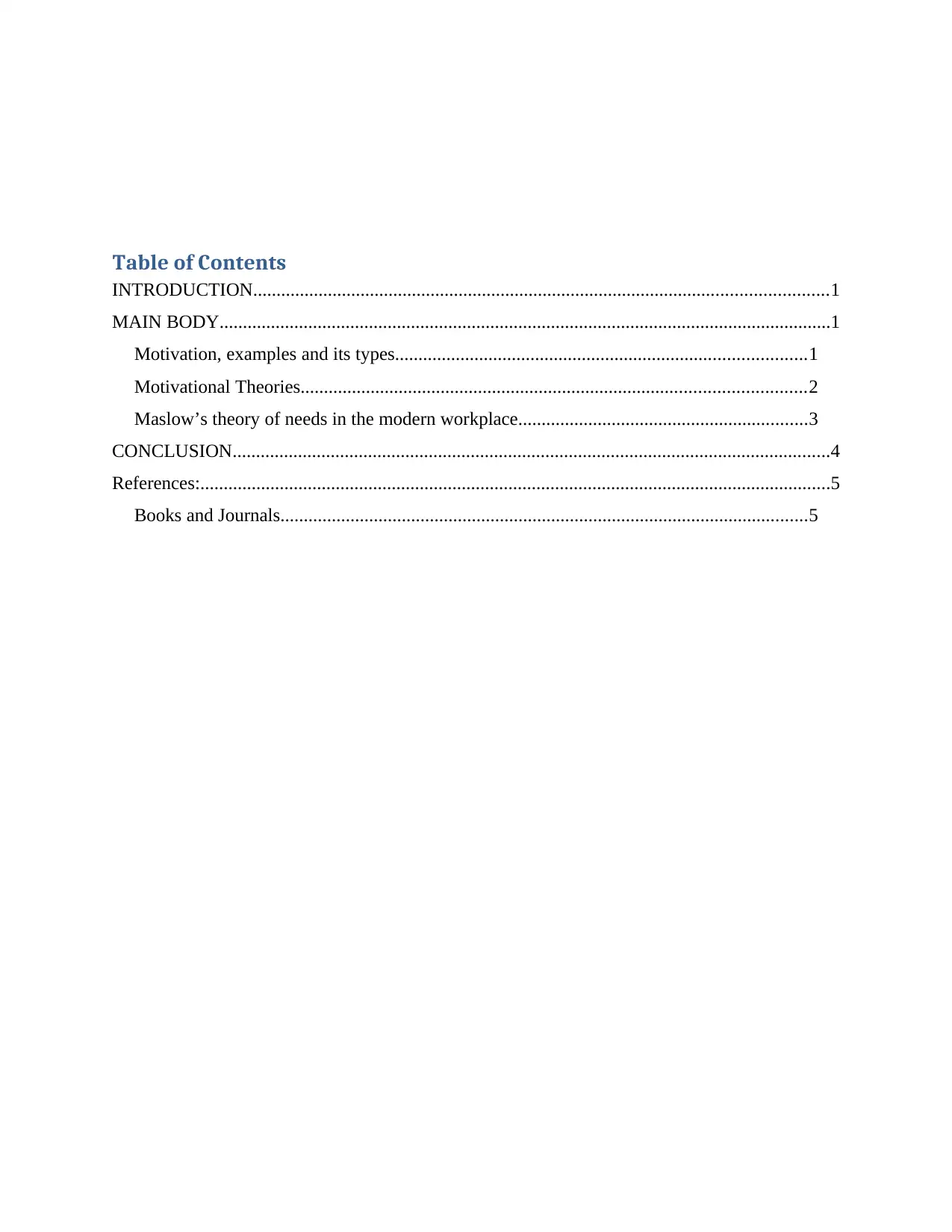
Table of Contents
INTRODUCTION...........................................................................................................................1
MAIN BODY...................................................................................................................................1
Motivation, examples and its types........................................................................................1
Motivational Theories............................................................................................................2
Maslow’s theory of needs in the modern workplace..............................................................3
CONCLUSION................................................................................................................................4
References:.......................................................................................................................................5
Books and Journals.................................................................................................................5
INTRODUCTION...........................................................................................................................1
MAIN BODY...................................................................................................................................1
Motivation, examples and its types........................................................................................1
Motivational Theories............................................................................................................2
Maslow’s theory of needs in the modern workplace..............................................................3
CONCLUSION................................................................................................................................4
References:.......................................................................................................................................5
Books and Journals.................................................................................................................5
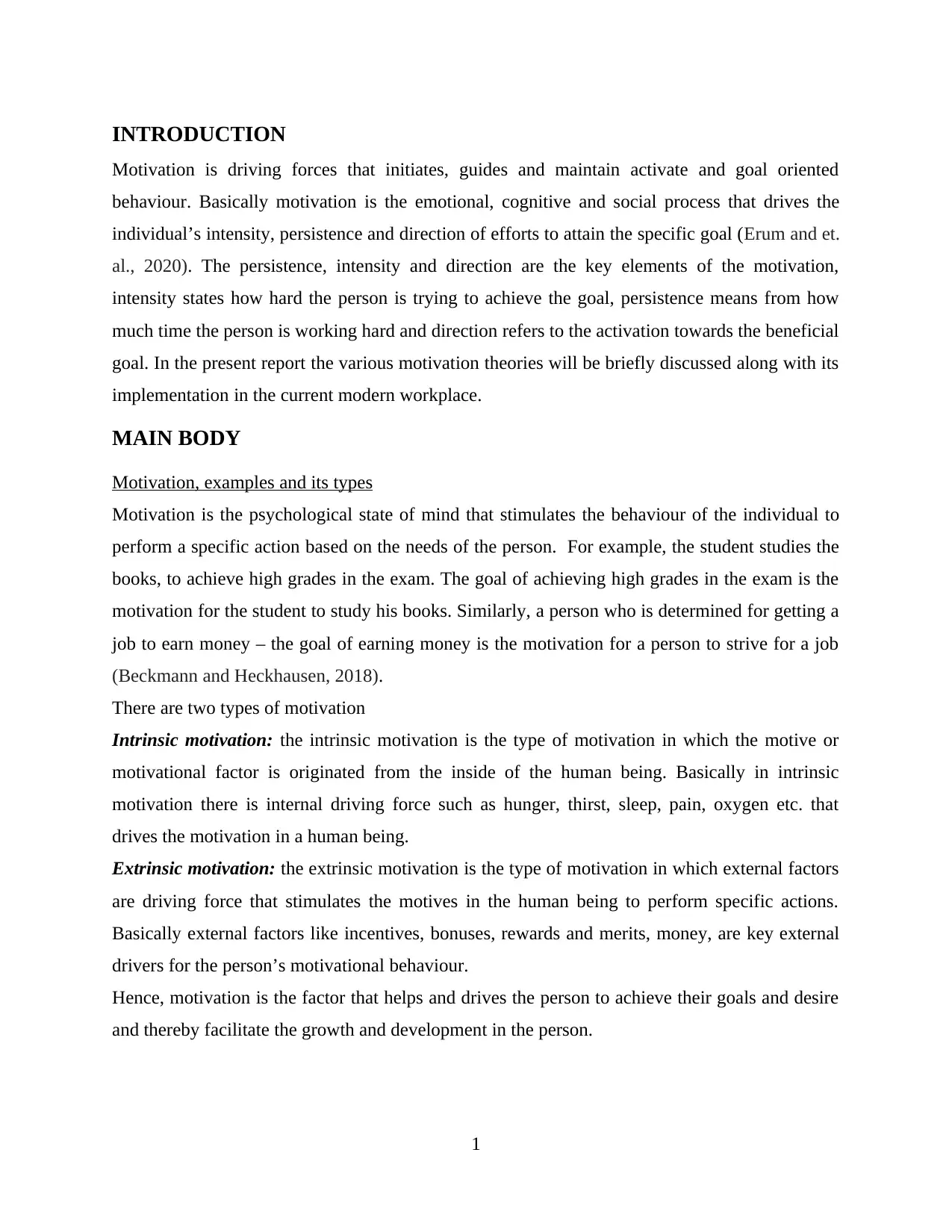
INTRODUCTION
Motivation is driving forces that initiates, guides and maintain activate and goal oriented
behaviour. Basically motivation is the emotional, cognitive and social process that drives the
individual’s intensity, persistence and direction of efforts to attain the specific goal (Erum and et.
al., 2020). The persistence, intensity and direction are the key elements of the motivation,
intensity states how hard the person is trying to achieve the goal, persistence means from how
much time the person is working hard and direction refers to the activation towards the beneficial
goal. In the present report the various motivation theories will be briefly discussed along with its
implementation in the current modern workplace.
MAIN BODY
Motivation, examples and its types
Motivation is the psychological state of mind that stimulates the behaviour of the individual to
perform a specific action based on the needs of the person. For example, the student studies the
books, to achieve high grades in the exam. The goal of achieving high grades in the exam is the
motivation for the student to study his books. Similarly, a person who is determined for getting a
job to earn money – the goal of earning money is the motivation for a person to strive for a job
(Beckmann and Heckhausen, 2018).
There are two types of motivation
Intrinsic motivation: the intrinsic motivation is the type of motivation in which the motive or
motivational factor is originated from the inside of the human being. Basically in intrinsic
motivation there is internal driving force such as hunger, thirst, sleep, pain, oxygen etc. that
drives the motivation in a human being.
Extrinsic motivation: the extrinsic motivation is the type of motivation in which external factors
are driving force that stimulates the motives in the human being to perform specific actions.
Basically external factors like incentives, bonuses, rewards and merits, money, are key external
drivers for the person’s motivational behaviour.
Hence, motivation is the factor that helps and drives the person to achieve their goals and desire
and thereby facilitate the growth and development in the person.
1
Motivation is driving forces that initiates, guides and maintain activate and goal oriented
behaviour. Basically motivation is the emotional, cognitive and social process that drives the
individual’s intensity, persistence and direction of efforts to attain the specific goal (Erum and et.
al., 2020). The persistence, intensity and direction are the key elements of the motivation,
intensity states how hard the person is trying to achieve the goal, persistence means from how
much time the person is working hard and direction refers to the activation towards the beneficial
goal. In the present report the various motivation theories will be briefly discussed along with its
implementation in the current modern workplace.
MAIN BODY
Motivation, examples and its types
Motivation is the psychological state of mind that stimulates the behaviour of the individual to
perform a specific action based on the needs of the person. For example, the student studies the
books, to achieve high grades in the exam. The goal of achieving high grades in the exam is the
motivation for the student to study his books. Similarly, a person who is determined for getting a
job to earn money – the goal of earning money is the motivation for a person to strive for a job
(Beckmann and Heckhausen, 2018).
There are two types of motivation
Intrinsic motivation: the intrinsic motivation is the type of motivation in which the motive or
motivational factor is originated from the inside of the human being. Basically in intrinsic
motivation there is internal driving force such as hunger, thirst, sleep, pain, oxygen etc. that
drives the motivation in a human being.
Extrinsic motivation: the extrinsic motivation is the type of motivation in which external factors
are driving force that stimulates the motives in the human being to perform specific actions.
Basically external factors like incentives, bonuses, rewards and merits, money, are key external
drivers for the person’s motivational behaviour.
Hence, motivation is the factor that helps and drives the person to achieve their goals and desire
and thereby facilitate the growth and development in the person.
1
⊘ This is a preview!⊘
Do you want full access?
Subscribe today to unlock all pages.

Trusted by 1+ million students worldwide
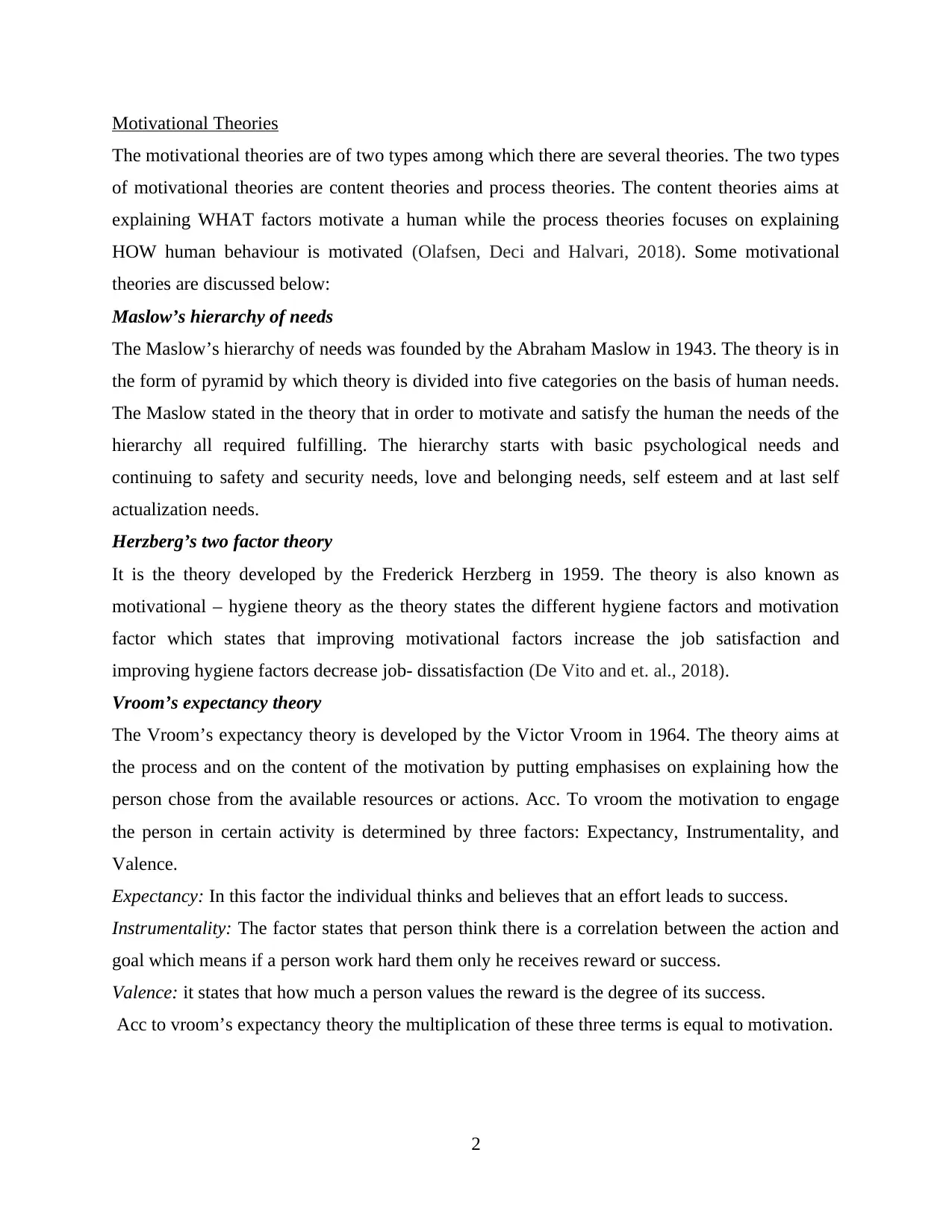
Motivational Theories
The motivational theories are of two types among which there are several theories. The two types
of motivational theories are content theories and process theories. The content theories aims at
explaining WHAT factors motivate a human while the process theories focuses on explaining
HOW human behaviour is motivated (Olafsen, Deci and Halvari, 2018). Some motivational
theories are discussed below:
Maslow’s hierarchy of needs
The Maslow’s hierarchy of needs was founded by the Abraham Maslow in 1943. The theory is in
the form of pyramid by which theory is divided into five categories on the basis of human needs.
The Maslow stated in the theory that in order to motivate and satisfy the human the needs of the
hierarchy all required fulfilling. The hierarchy starts with basic psychological needs and
continuing to safety and security needs, love and belonging needs, self esteem and at last self
actualization needs.
Herzberg’s two factor theory
It is the theory developed by the Frederick Herzberg in 1959. The theory is also known as
motivational – hygiene theory as the theory states the different hygiene factors and motivation
factor which states that improving motivational factors increase the job satisfaction and
improving hygiene factors decrease job- dissatisfaction (De Vito and et. al., 2018).
Vroom’s expectancy theory
The Vroom’s expectancy theory is developed by the Victor Vroom in 1964. The theory aims at
the process and on the content of the motivation by putting emphasises on explaining how the
person chose from the available resources or actions. Acc. To vroom the motivation to engage
the person in certain activity is determined by three factors: Expectancy, Instrumentality, and
Valence.
Expectancy: In this factor the individual thinks and believes that an effort leads to success.
Instrumentality: The factor states that person think there is a correlation between the action and
goal which means if a person work hard them only he receives reward or success.
Valence: it states that how much a person values the reward is the degree of its success.
Acc to vroom’s expectancy theory the multiplication of these three terms is equal to motivation.
2
The motivational theories are of two types among which there are several theories. The two types
of motivational theories are content theories and process theories. The content theories aims at
explaining WHAT factors motivate a human while the process theories focuses on explaining
HOW human behaviour is motivated (Olafsen, Deci and Halvari, 2018). Some motivational
theories are discussed below:
Maslow’s hierarchy of needs
The Maslow’s hierarchy of needs was founded by the Abraham Maslow in 1943. The theory is in
the form of pyramid by which theory is divided into five categories on the basis of human needs.
The Maslow stated in the theory that in order to motivate and satisfy the human the needs of the
hierarchy all required fulfilling. The hierarchy starts with basic psychological needs and
continuing to safety and security needs, love and belonging needs, self esteem and at last self
actualization needs.
Herzberg’s two factor theory
It is the theory developed by the Frederick Herzberg in 1959. The theory is also known as
motivational – hygiene theory as the theory states the different hygiene factors and motivation
factor which states that improving motivational factors increase the job satisfaction and
improving hygiene factors decrease job- dissatisfaction (De Vito and et. al., 2018).
Vroom’s expectancy theory
The Vroom’s expectancy theory is developed by the Victor Vroom in 1964. The theory aims at
the process and on the content of the motivation by putting emphasises on explaining how the
person chose from the available resources or actions. Acc. To vroom the motivation to engage
the person in certain activity is determined by three factors: Expectancy, Instrumentality, and
Valence.
Expectancy: In this factor the individual thinks and believes that an effort leads to success.
Instrumentality: The factor states that person think there is a correlation between the action and
goal which means if a person work hard them only he receives reward or success.
Valence: it states that how much a person values the reward is the degree of its success.
Acc to vroom’s expectancy theory the multiplication of these three terms is equal to motivation.
2
Paraphrase This Document
Need a fresh take? Get an instant paraphrase of this document with our AI Paraphraser
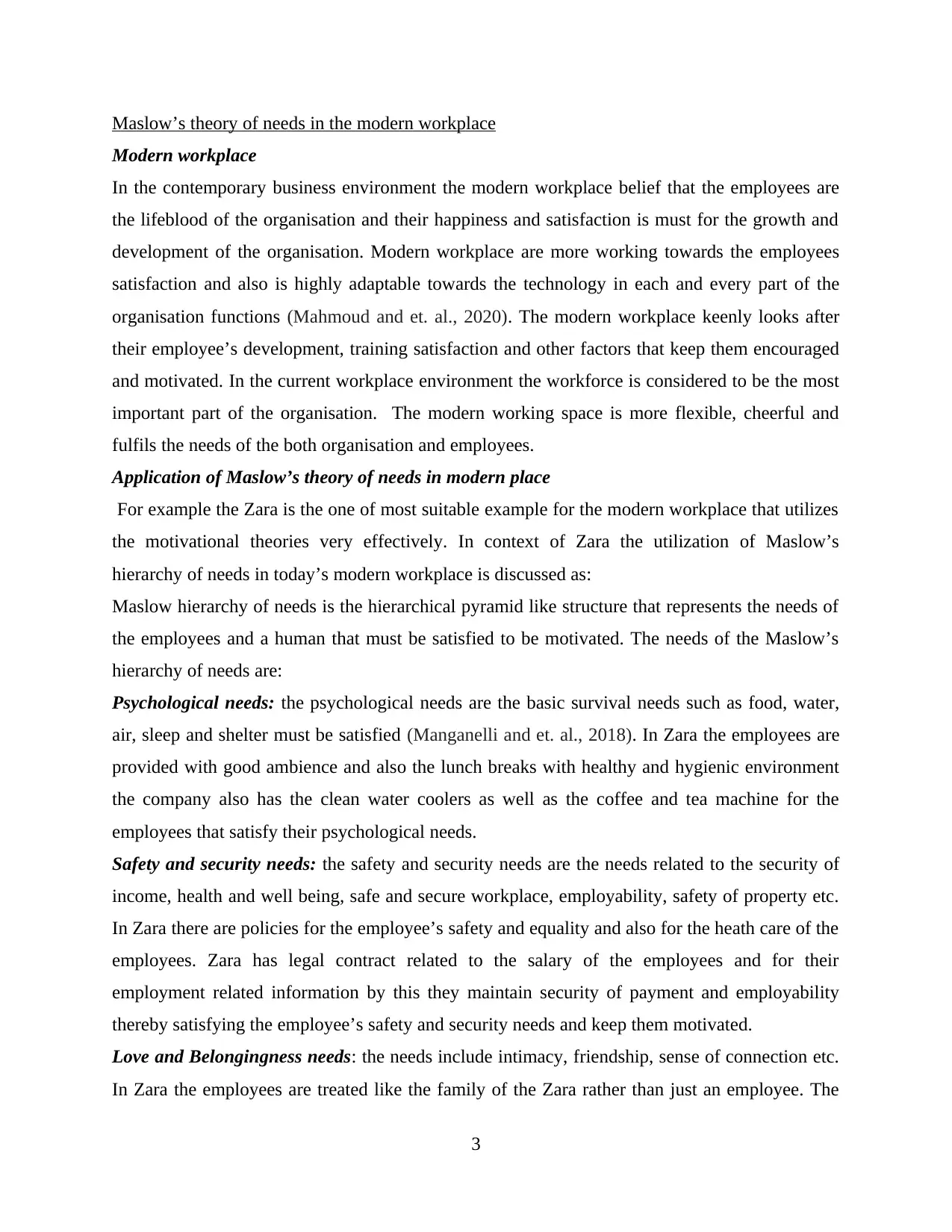
Maslow’s theory of needs in the modern workplace
Modern workplace
In the contemporary business environment the modern workplace belief that the employees are
the lifeblood of the organisation and their happiness and satisfaction is must for the growth and
development of the organisation. Modern workplace are more working towards the employees
satisfaction and also is highly adaptable towards the technology in each and every part of the
organisation functions (Mahmoud and et. al., 2020). The modern workplace keenly looks after
their employee’s development, training satisfaction and other factors that keep them encouraged
and motivated. In the current workplace environment the workforce is considered to be the most
important part of the organisation. The modern working space is more flexible, cheerful and
fulfils the needs of the both organisation and employees.
Application of Maslow’s theory of needs in modern place
For example the Zara is the one of most suitable example for the modern workplace that utilizes
the motivational theories very effectively. In context of Zara the utilization of Maslow’s
hierarchy of needs in today’s modern workplace is discussed as:
Maslow hierarchy of needs is the hierarchical pyramid like structure that represents the needs of
the employees and a human that must be satisfied to be motivated. The needs of the Maslow’s
hierarchy of needs are:
Psychological needs: the psychological needs are the basic survival needs such as food, water,
air, sleep and shelter must be satisfied (Manganelli and et. al., 2018). In Zara the employees are
provided with good ambience and also the lunch breaks with healthy and hygienic environment
the company also has the clean water coolers as well as the coffee and tea machine for the
employees that satisfy their psychological needs.
Safety and security needs: the safety and security needs are the needs related to the security of
income, health and well being, safe and secure workplace, employability, safety of property etc.
In Zara there are policies for the employee’s safety and equality and also for the heath care of the
employees. Zara has legal contract related to the salary of the employees and for their
employment related information by this they maintain security of payment and employability
thereby satisfying the employee’s safety and security needs and keep them motivated.
Love and Belongingness needs: the needs include intimacy, friendship, sense of connection etc.
In Zara the employees are treated like the family of the Zara rather than just an employee. The
3
Modern workplace
In the contemporary business environment the modern workplace belief that the employees are
the lifeblood of the organisation and their happiness and satisfaction is must for the growth and
development of the organisation. Modern workplace are more working towards the employees
satisfaction and also is highly adaptable towards the technology in each and every part of the
organisation functions (Mahmoud and et. al., 2020). The modern workplace keenly looks after
their employee’s development, training satisfaction and other factors that keep them encouraged
and motivated. In the current workplace environment the workforce is considered to be the most
important part of the organisation. The modern working space is more flexible, cheerful and
fulfils the needs of the both organisation and employees.
Application of Maslow’s theory of needs in modern place
For example the Zara is the one of most suitable example for the modern workplace that utilizes
the motivational theories very effectively. In context of Zara the utilization of Maslow’s
hierarchy of needs in today’s modern workplace is discussed as:
Maslow hierarchy of needs is the hierarchical pyramid like structure that represents the needs of
the employees and a human that must be satisfied to be motivated. The needs of the Maslow’s
hierarchy of needs are:
Psychological needs: the psychological needs are the basic survival needs such as food, water,
air, sleep and shelter must be satisfied (Manganelli and et. al., 2018). In Zara the employees are
provided with good ambience and also the lunch breaks with healthy and hygienic environment
the company also has the clean water coolers as well as the coffee and tea machine for the
employees that satisfy their psychological needs.
Safety and security needs: the safety and security needs are the needs related to the security of
income, health and well being, safe and secure workplace, employability, safety of property etc.
In Zara there are policies for the employee’s safety and equality and also for the heath care of the
employees. Zara has legal contract related to the salary of the employees and for their
employment related information by this they maintain security of payment and employability
thereby satisfying the employee’s safety and security needs and keep them motivated.
Love and Belongingness needs: the needs include intimacy, friendship, sense of connection etc.
In Zara the employees are treated like the family of the Zara rather than just an employee. The
3
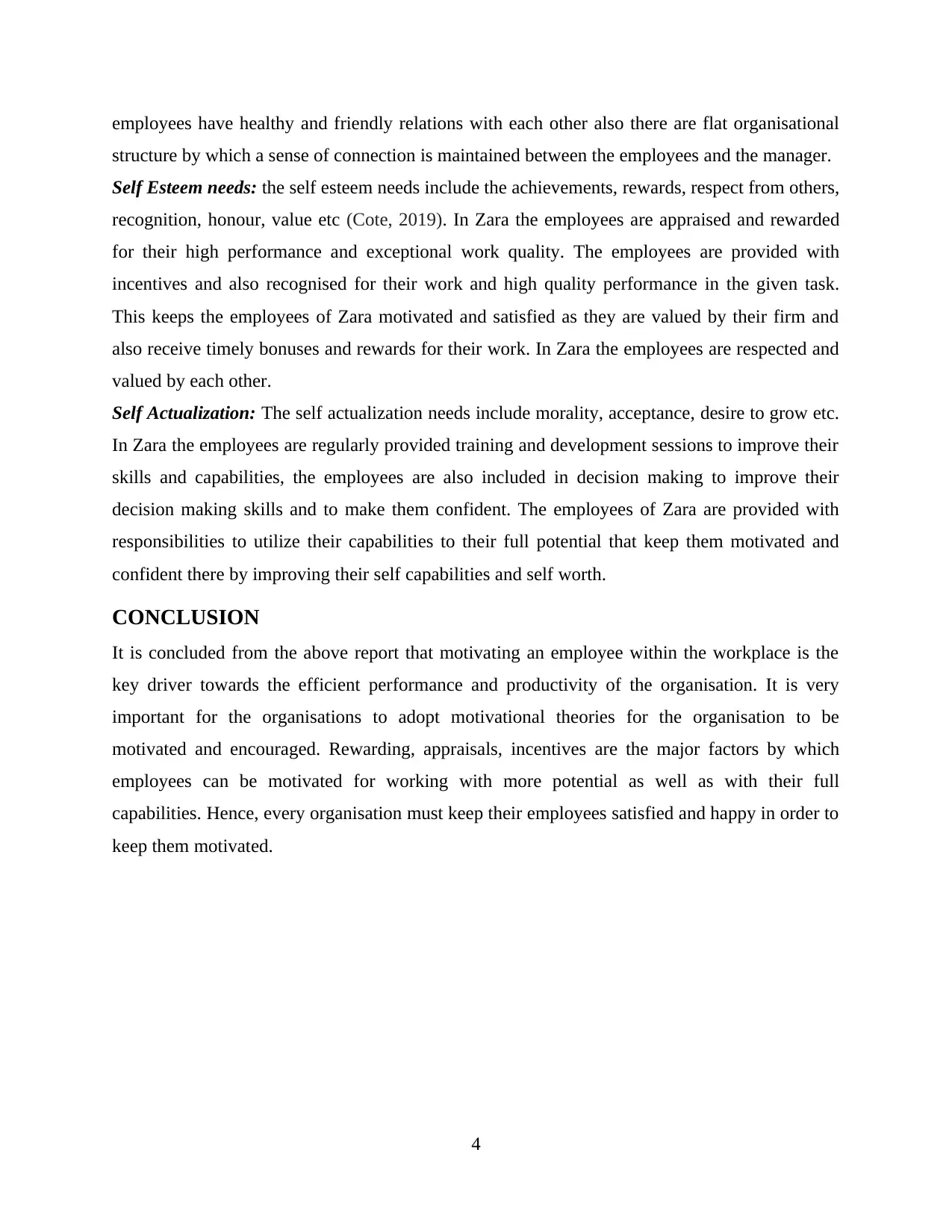
employees have healthy and friendly relations with each other also there are flat organisational
structure by which a sense of connection is maintained between the employees and the manager.
Self Esteem needs: the self esteem needs include the achievements, rewards, respect from others,
recognition, honour, value etc (Cote, 2019). In Zara the employees are appraised and rewarded
for their high performance and exceptional work quality. The employees are provided with
incentives and also recognised for their work and high quality performance in the given task.
This keeps the employees of Zara motivated and satisfied as they are valued by their firm and
also receive timely bonuses and rewards for their work. In Zara the employees are respected and
valued by each other.
Self Actualization: The self actualization needs include morality, acceptance, desire to grow etc.
In Zara the employees are regularly provided training and development sessions to improve their
skills and capabilities, the employees are also included in decision making to improve their
decision making skills and to make them confident. The employees of Zara are provided with
responsibilities to utilize their capabilities to their full potential that keep them motivated and
confident there by improving their self capabilities and self worth.
CONCLUSION
It is concluded from the above report that motivating an employee within the workplace is the
key driver towards the efficient performance and productivity of the organisation. It is very
important for the organisations to adopt motivational theories for the organisation to be
motivated and encouraged. Rewarding, appraisals, incentives are the major factors by which
employees can be motivated for working with more potential as well as with their full
capabilities. Hence, every organisation must keep their employees satisfied and happy in order to
keep them motivated.
4
structure by which a sense of connection is maintained between the employees and the manager.
Self Esteem needs: the self esteem needs include the achievements, rewards, respect from others,
recognition, honour, value etc (Cote, 2019). In Zara the employees are appraised and rewarded
for their high performance and exceptional work quality. The employees are provided with
incentives and also recognised for their work and high quality performance in the given task.
This keeps the employees of Zara motivated and satisfied as they are valued by their firm and
also receive timely bonuses and rewards for their work. In Zara the employees are respected and
valued by each other.
Self Actualization: The self actualization needs include morality, acceptance, desire to grow etc.
In Zara the employees are regularly provided training and development sessions to improve their
skills and capabilities, the employees are also included in decision making to improve their
decision making skills and to make them confident. The employees of Zara are provided with
responsibilities to utilize their capabilities to their full potential that keep them motivated and
confident there by improving their self capabilities and self worth.
CONCLUSION
It is concluded from the above report that motivating an employee within the workplace is the
key driver towards the efficient performance and productivity of the organisation. It is very
important for the organisations to adopt motivational theories for the organisation to be
motivated and encouraged. Rewarding, appraisals, incentives are the major factors by which
employees can be motivated for working with more potential as well as with their full
capabilities. Hence, every organisation must keep their employees satisfied and happy in order to
keep them motivated.
4
⊘ This is a preview!⊘
Do you want full access?
Subscribe today to unlock all pages.

Trusted by 1+ million students worldwide
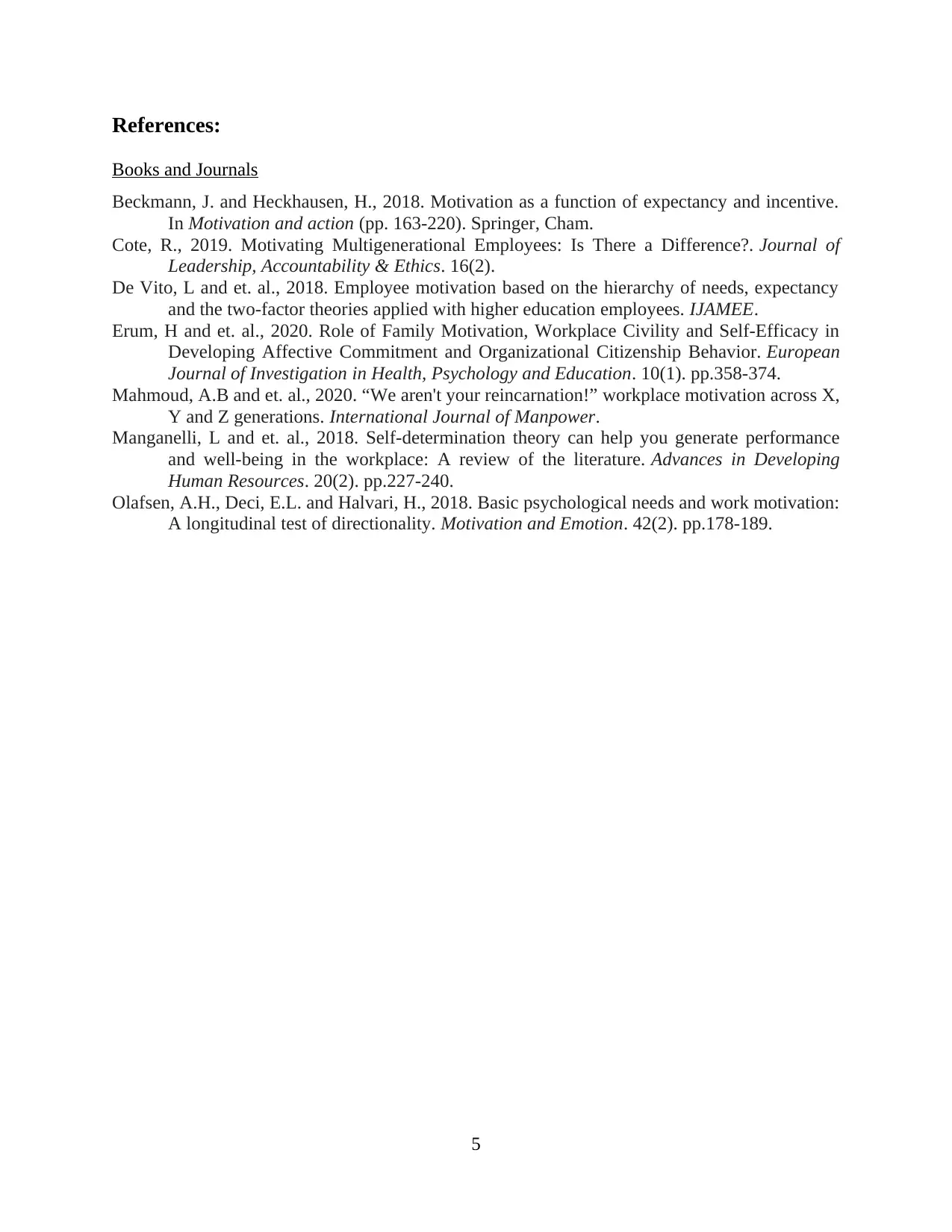
References:
Books and Journals
Beckmann, J. and Heckhausen, H., 2018. Motivation as a function of expectancy and incentive.
In Motivation and action (pp. 163-220). Springer, Cham.
Cote, R., 2019. Motivating Multigenerational Employees: Is There a Difference?. Journal of
Leadership, Accountability & Ethics. 16(2).
De Vito, L and et. al., 2018. Employee motivation based on the hierarchy of needs, expectancy
and the two-factor theories applied with higher education employees. IJAMEE.
Erum, H and et. al., 2020. Role of Family Motivation, Workplace Civility and Self-Efficacy in
Developing Affective Commitment and Organizational Citizenship Behavior. European
Journal of Investigation in Health, Psychology and Education. 10(1). pp.358-374.
Mahmoud, A.B and et. al., 2020. “We aren't your reincarnation!” workplace motivation across X,
Y and Z generations. International Journal of Manpower.
Manganelli, L and et. al., 2018. Self-determination theory can help you generate performance
and well-being in the workplace: A review of the literature. Advances in Developing
Human Resources. 20(2). pp.227-240.
Olafsen, A.H., Deci, E.L. and Halvari, H., 2018. Basic psychological needs and work motivation:
A longitudinal test of directionality. Motivation and Emotion. 42(2). pp.178-189.
5
Books and Journals
Beckmann, J. and Heckhausen, H., 2018. Motivation as a function of expectancy and incentive.
In Motivation and action (pp. 163-220). Springer, Cham.
Cote, R., 2019. Motivating Multigenerational Employees: Is There a Difference?. Journal of
Leadership, Accountability & Ethics. 16(2).
De Vito, L and et. al., 2018. Employee motivation based on the hierarchy of needs, expectancy
and the two-factor theories applied with higher education employees. IJAMEE.
Erum, H and et. al., 2020. Role of Family Motivation, Workplace Civility and Self-Efficacy in
Developing Affective Commitment and Organizational Citizenship Behavior. European
Journal of Investigation in Health, Psychology and Education. 10(1). pp.358-374.
Mahmoud, A.B and et. al., 2020. “We aren't your reincarnation!” workplace motivation across X,
Y and Z generations. International Journal of Manpower.
Manganelli, L and et. al., 2018. Self-determination theory can help you generate performance
and well-being in the workplace: A review of the literature. Advances in Developing
Human Resources. 20(2). pp.227-240.
Olafsen, A.H., Deci, E.L. and Halvari, H., 2018. Basic psychological needs and work motivation:
A longitudinal test of directionality. Motivation and Emotion. 42(2). pp.178-189.
5
1 out of 7
Related Documents
Your All-in-One AI-Powered Toolkit for Academic Success.
+13062052269
info@desklib.com
Available 24*7 on WhatsApp / Email
![[object Object]](/_next/static/media/star-bottom.7253800d.svg)
Unlock your academic potential
Copyright © 2020–2025 A2Z Services. All Rights Reserved. Developed and managed by ZUCOL.




